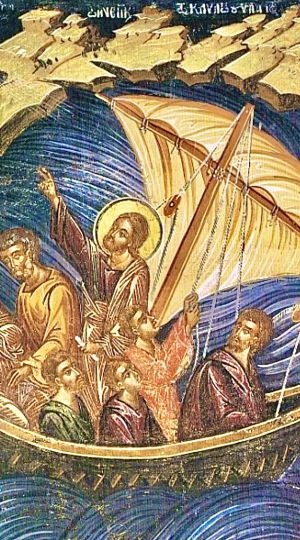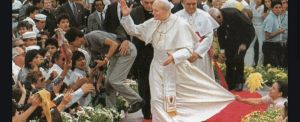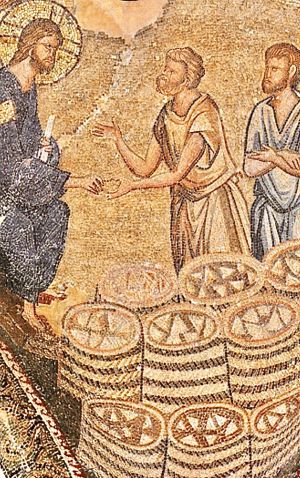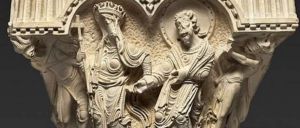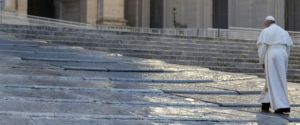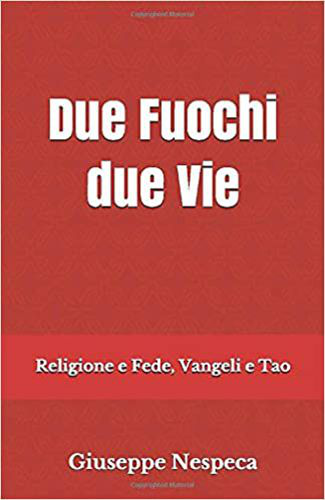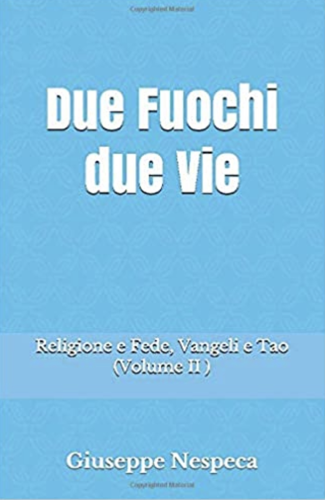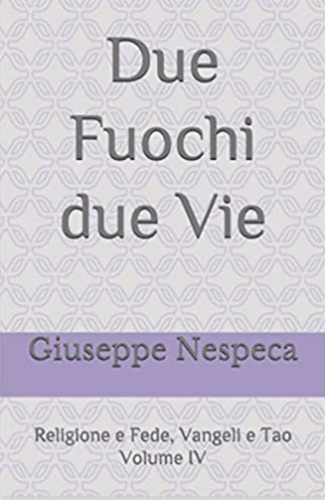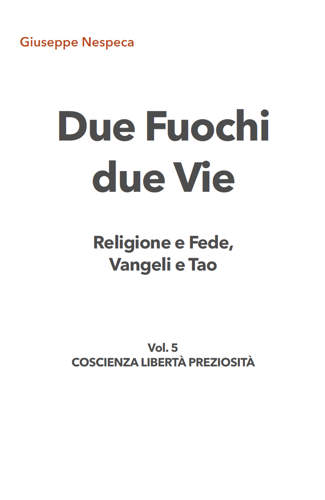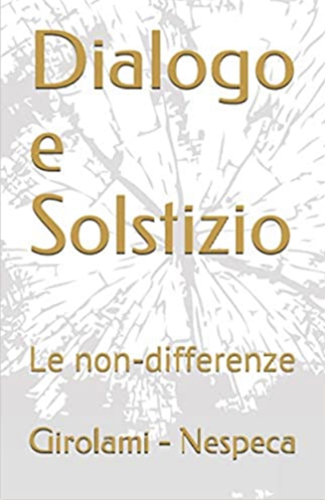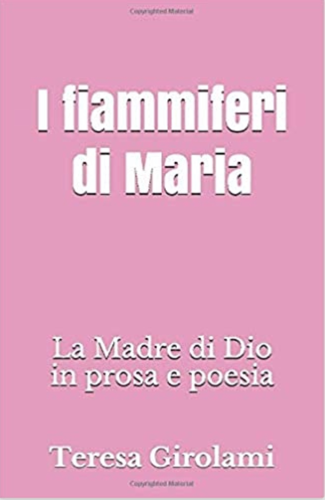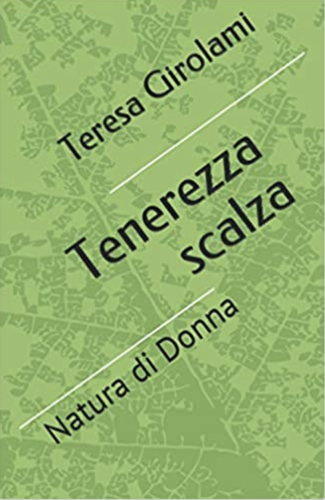
don Giuseppe Nespeca
Giuseppe Nespeca è architetto e sacerdote. Cultore della Sacra scrittura è autore della raccolta "Due Fuochi due Vie - Religione e Fede, Vangeli e Tao"; coautore del libro "Dialogo e Solstizio".
On troubled waters, with a headwind
(Mk 6:45-52)
Roman communities of the time of Mk [the year of the four Caesars] were on the high seas and the disciples seemed to be alone: the Master had now reached safe Land (vv.46-47).
In the dark, though they wanted to move forward, the tiny fraternities were confused by the ongoing civil war, marginalised by the ideology of power, battered by headwinds.
Using paraphrases from the book of Exodus and Isaiah [new Exodus], Mk seeks to help his communities understand the Mystery of the Person of Jesus.
In particular, the presence of the Father in Him, and that 'Someone within something': in the events of their life experience, also torn by internal polemics.
In such growth, there arises the essential awareness of the 'God-with-us'.
Only the Risen One overcomes the fear of upheavals, but does so without rushing in.
And He even wants to go beyond the storms in which the disciples seem to get wrapped up and lost (v.48).
He is devoid of established patterns that would frame Him forever: it would be like making Him evasive and making Him perish. Indeed - like the disciples of Emmaus - they do not recognise Him (vv.49-50).
But if we were all to welcome Him in the «little boat» (v.51), amazed within ourselves [cf. Greek text] we would realise that there is another Kingdom, where each element is in His power.
The invisible Friend guides and fulfils infallibly, and brings us to «shore» (v.53) - a ‘final condition’ that the force of the waves cannot affect, even when we have the feeling of being swept away by the floatings.
Precisely in the condition of tossed pilgrims, in approaching his Person we would experience a strange and 'different stability': the persistence against the current.
A crossing towards the freedom that 'comes'... from clinging to 'Jesus within' alone. In the chaos of securities, with no guarantees - because the Lord does not take us out of eddies and oscillating situations, to die in norms, or expected conformisms.
Ours is a discordant permanence, fluctuating; and actuating, but in reversals.
The fatigue of questioning ourselves and the suffering that the adventure of Faith hold, will also fade amidst the troubles of the rough seas.
It is enough to disengage oneself from fixed ideas of stability, even religious stability, and to listen to life as it is, embracing it, even in its throng of bumps, bitterness, dashed hopes of harmony, sorrows - engaging with this torrent of new emergencies, and encountering one's own profound nature.
The best vaccine against the anxieties of adventuring together with Christ on the changing waves of the unexpected will be precisely not to avoid worries upstream - rather, to go towards them and welcome them; to recognise oneself, to let them happen.
Even in the time of global crisis, the apprehensions that seem to want to devastate us again, come to us as preparatory energies for other joys that wish to break through - for new cosmic attunements; for amazement starting with ourselves. And guidance of the beyond.
Our little boat is in an upside down, inverted, unequal stability; uncertain, unseemly - yet energetic, prickly, capable of reinventing itself.
It may even be overstretched, but from disarray.
Weekday Liturgy, January 9
Little fishes on troubled waters, with a headwind
(Mk 6:45-52)
«Excita, Domine, potentiam tuam, et veni
"Excita, Domine, potentiam tuam, et veni" - with these and similar words the liturgy of the Church repeatedly prays [...].
These invocations were probably formulated in the period of the decline of the Roman Empire. The disintegration of the supporting orders of law and of the basic moral attitudes, which gave them strength, caused the breaking of the banks that had hitherto protected peaceful coexistence between men. A world was passing away. Frequent natural cataclysms further increased this experience of insecurity. No force could be seen to halt this decline. All the more insistent was the invocation of God's own power: that He would come and protect men from all these threats.
"Excita, Domine, potentiam tuam, et veni". Today, too, we have many reasons to associate ourselves with this prayer [...] The world with all its new hopes and possibilities is, at the same time, distressed by the impression that the moral consensus is dissolving, a consensus without which legal and political structures do not function; consequently, the forces mobilised to defend these structures seem doomed to failure.
Excita - the prayer is reminiscent of the cry addressed to the Lord, who was sleeping in the disciples' storm-tossed boat that was close to sinking. When His powerful word had calmed the storm, He rebuked the disciples for their little faith (cf. Mt 8:26 and par.). He wanted to say: in yourselves faith has slept. He also wants to say the same thing to us. Even in us so often faith sleeps. Let us therefore pray to Him to awaken us from the sleep of a faith that has become tired and to restore to faith the power to move mountains - that is, to give right order to the things of the world».
[Pope Benedict, to the Roman Curia 20 December 2010].
The Roman communities of the time of Mk (the year of the four Caesars) were on the high seas and the disciples seemed to be alone: the Master had by this time gained the dry land (vv.46-47).
In the dark, though they wanted to advance, the tiny fraternities were confused by the ongoing civil war, marginalised by the ideology of power, battered by headwinds.
And they were catching nothing. They were only exposing themselves to hostile forces and it seemed to them that they were sinking with no chance of escape or future.
Our life, too, proceeds as on a small boat tossed about by earthquakes. We go hopeful, and yet adversity threatens to drown us, and with us it seems to drag all of life down.
Critical episodes, but they make us realise how much Christ's friendship is worth to us and what it conveys. Of course, God is no substitute for human work.
Only the Risen One overcomes the fright of upheavals, but he does so without rushing in, and even wants to go beyond the storms in which the disciples seem to get wrapped up and lost (v.48).
He is devoid of established patterns that would frame him forever (it would be like making him evasive and making him perish). Indeed - like the disciples of Emmaus - they do not recognise him (vv.49-50).
But if we welcome him in a simple and straightforward way in our little boat (v.51), amazed within ourselves (cf. Greek text) we realise that there is another kingdom, that everything is in his power.
Unless we reduce the Lord to our own ideas or strengths and desires - everything will serve to revive us, even the headwind and the pitfalls of the sea (a figure of evil). And while frying, our Faith will be bold and combative, not warlike.
The unseen Friend guides and fulfils infallibly, and brings us to shore (v.53) - an ultimate condition that the force of the waves cannot affect, not even when we have the feeling of being swept away by the waves.
Using paraphrases from the book of Exodus and Isaiah (New Exodus), Mk seeks to help his communities understand the Mystery of the Person of Jesus: the presence of the Father in Him - and in the events of their life experience, also torn by internal controversies.
Up to the second generation of believers, not a few Jewish converts considered Christ to be a person in line with their mentality and tradition, in agreement with the prophecies and figures of the First Testament.
Conversely, some pagans who had accepted Jesus as Lord advocated rather an understanding with the worldly mentality - a kind of agreement between the Son of God and the Empire.
But could the alliance of the new Faith with the ideology and imagery of domination have calmed the storms?
The situation of the tiny fraternities at the centre of the Empire was still dark and unstable. Christ seemed not quite there (he never wants his own to be disengaged!) and the sea was rough, the wind at the bow. Could the Exodus be re-created?
Faith in the Delivering God was shaken; not distressed - but distressed. The disciples did not possess the same calm trust in the Master as they did in the Father.They maintained their own mentality, clouded and unmoving (vv.49-52).
In spite of everything, and precisely in the condition of stranded pilgrims, in approaching his Person they experienced a strange and different stability: the persevering against the tide and the proceeding - in overcoming alienations.
A crossing to freedom that came from clinging to Jesus alone inside, in the chaos of securities, without guarantees - because the Lord does not take us out of eddies and swinging situations, to die in norms (or expected conformisms).
Ours is a discordant permanence, fluctuating; and actuating, but in reversals.
Hence not feudal: not with a reassuring tradition alternative - not mediated by that 'power' of civitas christiana that would extinguish the strength to renew us (and exhaust us).
Even today, it is the path of non-habitual, critical growth that reveals Him capable of manifesting His quiet power, returning the disrupted elements to calm - and us to the power of human faculties.
Says the Tao Tê Ching (LX) that suggests we stand in regal dignity: "Ruling a great kingdom is like frying minute fish". Master Wang Pi specifies the reason: "(The ruler) does not turn them over. If he is restless he does harm, if he is quiet he keeps his genuineness intact'.
Master Ho-shang Kung comments: "When small fish are fried, one does not remove their innards and scales, nor dare one shake them, lest they fall apart. When the government of the state is harassed, the subjects are seditious; when the government of the person is harassed, the essence is dispersed'.
More than the opposing frictions and external events, anxiety, impression and anguish come from the very fear of facing the normal issues of existence.
This is perhaps out of personal or ecclesial mistrust: feeling in danger simply because we perceive ourselves to be intimately undeveloped, incapable of other dialogue and reworking, converting or reshaping.
The fatigue of questioning ourselves and the suffering that the adventure of Faith holds, will also fade amidst the discomfort of the rough seas.
It is enough to disengage oneself from fixed ideas of stability, even religious stability, and listen to life as it is, embracing it, even in its throng of bumps, bitterness, dashed hopes of harmony, sorrows - engaging with this flood of new emergencies, and encountering one's own deep nature.
The best vaccine against the anxieties of adventuring together with Christ on the changing waves of the unexpected will be precisely not to avoid worries upstream - rather, to go towards them and welcome them; to recognise them, to let them happen.
Even in the time of global crisis, the apprehensions that seem to want to devastate us, come to us as preparatory energies for other joys that wish to break through - for new cosmic attunements; for amazement from within ourselves, and guidance of the beyond.
Our little boat is in an inverted, inverted, unequal stability; uncertain, unbecoming - yet energetic, prickly, capable of reinventing itself. And it will even be overstretched, but with disruption.
To internalise and live the message:
On what occasions have you found easy what before seemed impossible?
God as hostage, or the different view of danger (Mk 4:35-41)
The whole Gospel of Mk is an articulate response to the question: who is Jesus (v.41)? His direction of travel seems to go against the grain, and he brazenly breaks the rules accepted by all.
While the disciples were fondling nationalist desires, the Master begins to make it clear that He is not the vulgarly expected Messiah, restorer of the defunct empire of David or the Caesars (fighting for succession under the eyes of the Roman community of Mk: Galba, Otone, Vitellius, Vespasian).
The Kingdom of God is open to all mankind, which in those turbulent times - torn apart by the swift but bloody civil war following Nero's follies - seeks security, welcome, points of reference. Everyone can find home and shelter there (Mk 4:32b).
But the apostles and church veterans seem averse to Christ's proposals; they remain insensitive to an overly broad idea of fraternity - which displaces them. This is a live and very serious problem.
The teaching and reminder imposed on the disciples is to go to the other shore (v.35), that is, not to keep for themselves, but to communicate the riches of the Father to the pagans, who are considered impure and infamous.
Yet his own people do not want to know about risky disproportions that would actually make the action of the Son of God stand out. They are calibrated to the customs of common religiosity and a circumscribed ideology of power.
Therefore, in order to exorcise the danger of the mission - and having to accommodate people, rework situations, welcome surprises that would shake them up (questioning them) - they try to take the Master hostage (v.36).
The resistance to the divine commission and the resulting lacerating internal debate unleashes a great storm in the assemblies of believers."And there came a great gale of wind. And the waves rolled in the boat, so that the boat was already full" (v.37).
The storm concerns the disciples alone, the only ones dismayed; not Jesus - at the stern, at the helm (v.36 - and on the "cushion": it is the Risen One).
What happens "inside" is not a mere reflection of what happens "outside"! This is the error to be corrected.
Such identification blocks and makes life chronic, starting with the handling of emotionally relevant situations - which have their own meaning. They carry a meaningful appeal, they introduce a different eye and dialogue.
Even from the peace of the divine condition that dominates chaos (v.39), the Lord calls attention to and rebukes the apostles, accusing them of not having faith, that is, an ounce of risk of love - like a grain of mustard seed (v.31) - to bring to humanity to renew it.
In short, we are confused, we create embarrassment, and the chaos of schemes and selfishness rages on? We are paradoxically going in the right direction, but we must not be overcome by fear.
In Him, we are imbued with a different view of danger.
Says the Tao Tê Ching (xxii): "The saint does not see by himself, therefore he is enlightened". Even in straits.
Indeed, it seems that Jesus expressly wanted the dark moments of confrontation and doubt for the apostles (v.35). Even for us, even if we were church leaders... because otherwise there will be no cleansing from repetitive convictions.
Textbook expectations (and the habit of setting up conformist harmonies) block the flowering of what we are and hope for.
Especially what is annoying or even 'against' has something decisive to tell us. Even in the church boat (v.36), discomfort must express itself.
It is to revive the essence of each person and of the community itself, to introduce change (hidden or repressed) and activate it in the most effective way... by contact with the hidden, primordial energies.
More than the opposing frictions and conflicting external events, anxiety, impression and anguish come from the very fear of facing the normal or decisive questions of existence.
This is out of mistrust: feeling in danger perhaps only because we perceive ourselves to be intimately undeveloped, incapable of other conversation, of discovering and reworking, converting, or remodelling.
The fatigue of questioning ourselves and the suffering that the adventure of Faith holds, will also fade amidst the discomfort of the rough sea - which precisely does not want us to return to 'those of before'.
It is enough to disengage oneself from the idea of stability, even religious stability, and listen to life as it is, embracing it, even in its throng of bumps, bitterness, dashed hopes of harmony, sorrows - engaging with this flood of new emergencies, and encountering one's own profound nature.
The best vaccine against the anxieties of adventuring together with Christ on the changing waves of the unexpected will be precisely not to avoid worries upstream - rather, to go towards them and welcome them; to recognise them, to let them happen.
Even in the time of global crisis, the apprehensions that seem to want to devastate us, come to us as preparatory energies of other joys that wish to break through - new cosmic attunements; for the amazement starting with ourselves, and the guidance of the beyond.
Our little boat is in an inverted, inverted, unequal stability; uncertain, unbecoming - yet energetic, prickly, capable of reinventing itself. And it may even be excessive, but it is disruptive.
For a proposal of Tenderness (not corresponding) that is not a relaxation zone, because it rhymes with terrible anxiety and... suburbs!
Some other providence, which you ignore
"It is good not to fall, or to fall and rise again. And if you do happen to fall, it is good not to despair and not to become estranged from the love the Sovereign has for man. For if he wills, he can do mercy to our weakness. Only let us not turn away from him, let us not be distressed if we are forced by the commandments, and let us not be disheartened if we come to nothing (...).
Let us neither hurry nor retreat, but always begin again (...).
Wait for him, and he will show you mercy, either by conversion or by trials, or by some other providence that you do not know."
[Peter Damascene, Second Book, Eighth Discourse, in La Filocalia, Turin 1982, I,94]
He lowers the Heavens
This is an episode from which the Fathers of the Church drew a great wealth of meaning. The sea symbolizes this life and the instability of the visible world; the storm points to every kind of trial or difficulty that oppresses human beings. The boat, instead, represents the Church, built by Christ and steered by the Apostles.
Jesus wanted to teach the disciples to bear life’s adversities courageously, trusting in God, in the One who revealed himself to the Prophet Elijah on Mount Horeb “in a still small voice” [the whispering of a gentle breeze] (1 Kings 19:12) [...]
Even before we seek the Lord or invoke him, it is he himself who comes to meet us, who lowers Heaven to stretch out his hand to us and raise us to his heights; all he expects of us is that we trust totally in him, that we really take hold of his hand.
Let us call on the Virgin Mary, model of total entrustment to God, so that amidst the plethora of anxieties, problems and difficulties which churn up the sea of our life, may our hearts resonate with the reassuring words of Jesus who also says to us “Take heart, it is I; have no fear!”; and may our faith in him grow.
[Pope Benedict, Angelus 7 August 2011]
Sign of a constant Presence
The storm calmed on the Lake of Genesaret can be reread as a "sign" of Christ's constant presence in the "boat" of the Church, which many times throughout history is exposed to the fury of the winds during stormy hours. Jesus, awakened by the disciples, commands the winds and the sea to be becalmed. Then he says to them, "Why are you so fearful? Have you no faith yet?" (Mk 4:40). In this, as in other episodes, one can see Jesus' desire to inculcate in the apostles and disciples faith in his operative and protective presence even in the most stormy hours of history, in which doubt about his divine assistance could infiltrate the spirit. In fact, in Christian homiletics and spirituality, the miracle has often been interpreted as a 'sign' of Jesus' presence and a guarantee of trust in him on the part of Christians and the Church.
[Pope John Paul II, General Audience 2 December 1987]
Hardened hearts
A hardened heart cannot comprehend even the greatest miracles. But "how does a heart harden?" Pope Francis asked this question during the Mass celebrated on Friday 9 January at Santa Marta.
The disciples, we read in the liturgical passage from Mark's Gospel (6:45-52), "had not understood the fact of the loaves: their hearts were hardened". Yet, Francis explained, 'they were the apostles, Jesus' closest ones. But they did not understand'. And although they had witnessed the miracle, although they had "seen that those people - more than five thousand - had eaten with five loaves" they had not understood. "Why? Because their hearts were hardened".
So many times Jesus "speaks of hardness of heart in the Gospel", rebukes the "hard-necked people", weeps over Jerusalem "who did not understand who he is". The Lord confronts this hardness: "So much work has Jesus done," the Pope stressed, "to make this heart more docile, to make it without hardness, to make it loving. A 'work' that continues after the resurrection, with the disciples of Emmaus and so many others.
"But," the Pontiff wondered, "how does a heart harden? How is it possible that these people, who were with Jesus always, every day, who heard him, saw him... and their hearts were hardened. But how can a heart become like that?" And he related: "Yesterday I asked my secretary: Tell me, how does a heart become hardened? He helped me to think about this a little". Hence the indication of a series of circumstances with which everyone can compare their personal experience.
First of all, Francis said, the heart "is hardened by painful experiences, by hard experiences". This is the situation of those who 'have had a very painful experience and do not want to enter into another adventure'. This is precisely what happened after the resurrection to the disciples of Emmaus, whose remarks the Pontiff imagined: "'There is too much, too much noise, but let's go away a little, because...'" -Why, what? - "Eh, we hoped that this was the Messiah, there was no Messiah, I don't want to delude myself again, I don't want to delude myself!".
Here is the heart hardened by an "experience of sorrow". The same happens to Thomas: 'No, no, I don't believe it. If I don't put my finger there, I don't believe it!". The disciples' hearts were hardened 'because they had suffered'. And in this regard Francis recalled a popular Argentinean saying: 'If a person is burnt by milk, when he sees the cow he cries'. That is, he explained, 'it is that painful experience that keeps us from opening our hearts'.
Another reason that hardens the heart is then 'closure in oneself: making a world in oneself'. It happens when man is "closed in on himself, in his community or his parish". It is a closure that "can revolve around many things": around "pride, sufficiency, thinking that I am better than others" or even "vanity". The Pope specified: "There are the 'mirror' men and women, who are closed in on themselves to look at themselves, continuously": they could be called 'religious narcissists'. These "have hard hearts, because they are closed, they are not open. And they try to defend themselves with these walls they make around themselves'.
There is a further reason that hardens the heart: insecurity. This is what is experienced by the person who thinks: 'I don't feel secure and I look for somewhere to cling to in order to be safe'. This attitude is typical of people 'who are so attached to the letter of the law'. It happened, the Pontiff explained, "with the Pharisees, with the Sadducees, with the doctors of the law of Jesus' time". They would object: "But the law says this, but it says this up to here...", and so "they would make another commandment"; in the end, "poor things, they would take on 300-400 commandments and feel secure".
In reality, Francis pointed out, all these 'are safe people, but just as a man or a woman in a prison cell behind the grate is safe: it is a security without freedom'. Whereas it is precisely freedom that 'Jesus came to bring us'. St Paul, for example, reproaches James and also Peter "because they do not accept the freedom that Jesus brought us".
Here then is the answer to the initial question: "How does a heart harden?". For the heart, "when it hardens, it is not free, and if it is not free, it is because it does not love". A concept expressed in the first reading of the day's liturgy (1 John 4:11-18), where the apostle speaks of "perfect love" that "casts out fear". For "in love there is no fear, because fear presupposes punishment, and he who fears is not perfect in love. He is not free. He always has the fear that something painful, sad will happen", that we will "go wrong in life or risk eternal salvation". In reality, these are only 'imaginations', because that heart simply 'does not love'. The disciples' hearts, the Pope explained, "were hardened because they had not yet learned to love".We can then ask: "Who teaches us to love? Who frees us from this hardness?" "Only the Holy Spirit can do it," Francis clarified, pointing out, "You can do a thousand catechesis courses, a thousand spirituality courses, a thousand yoga courses, Zen and all these things. But all this will never be able to give you the freedom of a son". Only the Holy Spirit "moves your heart to say 'father'"; only he "is able to drive out, to break this hardness of heart" and make it "docile to the Lord. Docile to the freedom of love". It is no coincidence that the disciples' hearts remained "hardened until the day of the Ascension", when they said to the Lord: "Now the revolution will take place and the kingdom will come!" In reality "they understood nothing". And "only when the Holy Spirit came did things change".
Therefore, the Pontiff concluded, "let us ask the Lord for the grace to have a docile heart: may he save us from the slavery of a hardened heart" and "bring us forward into that beautiful freedom of perfect love, the freedom of the children of God, that which only the Holy Spirit can give".
[Pope Francis, S. Marta homily, in L'Osservatore Romano 10/01/2015]
The diverse solution. Vocation to offer the world
Multiplication by Sharing
(Mk 6:34-44)
«Man is a limited being who is himself limitless» (Fratelli Tutti [Brethren All] n.150).
In our hearts we have a great longing for fulfilment and Happiness. The Father has introduced it, He Himself satisfies it - but He wants us to be associated with His work - inside and outside.
The Son reflects God's plan in compassion for the crowds in need of everything and - despite the plethora of teachers and experts - lacking any authentic teaching (v.34).
His solution is very different from that of all “spiritual” guides, because He does not gloss over us with an indirect paternalism (v.37) that wipes away tears, heals wounds, erases humiliations.
He invites us to make in person use of what we are and have, even though it may seem ridiculous. But He teaches in no uncertain terms that by shifting energies, prodigious results are achieved.
This is how we respond in Christ to the world's great problems: by recovering the condition of the man ‘viator’ - a passing being, her/his essential mark - and by sharing goods; not letting everyone make do (v.36).
Our real nakedness, the vicissitudes and experience of the many different brothers and sisters, are resources not to be evaluated with distrust, «viewing others as competitors or dangerous enemies» of our fulfilment (FT no.152).
Not only will the little we bring be enough to satiate us, but it will advance for others and with identical fullness of truth, human, epochal (vv.42-43).
The new people of God are not a crowd of chosen and pure people. Everyone brings with them problems, which the Lord heals - taking care not by proxy measures (v.37), as if from above or from without.
In short: another world is possible, but through breaking one's own (even miserable) bread and companion (v.38).
An authentic solution, if one brings it out from within, and by standing in the midst - not in front, not in charge, not at up high (v.36).
The place of God's revelation was to be the place of thunderbolts, on a "mountain" steaming like a furnace (Ex 19:18)... but finally even Elijah's violent zeal had to recant (1 Kings 19:12).
Even to women and men on the other side (vv.31-32) the Son reveals a Father who does not simply erase infirmities, but makes them understood as a place that is preparing a personal development, and that of the Community.
It was imagined that in the time of the Messiah, all the needy would disappear (Is 35:5ff.). ‘Golden age’: everything at the top, no abyss.
In Jesus - distributed Bread - an unusual fullness of times is manifested, apparently nebulous and fragile (v.38) but real and able to reboot people and relationships.
Our shortcomings make us attentive, and unique. They are not to be despised, but taken up, placed in the Son's hands and energised (v.41).
The same falls can be a precious sign; in Christ, they are no longer mere humiliations, but path indicators (vv.32-34): perhaps we are not using and investing our resources to the best of our ability.
Thus collapses can be quickly transformed into (different, unpacked) ascents and a search for total completion in Communion.
The image of the Kingdom in the puny Eucharist does not eliminate the flaw and death: it takes them up and transfigures them into strengths; by creating encounter, dialogue, predilection for the least realities - and New Covenant.
[Weekday Liturgy of 8 January]
Multiplication by Sharing
The very different solution
(Mk 6:34-44)
«Man is a limited being who is himself limitless» (Fratelli Tutti [Brethren All] n.150).
In our hearts we have a great longing for fulfilment and Happiness. The Father has introduced it, He Himself satisfies it - but He wants us to be associated with His work - inside and outside.
The Son reflects God's design in compassion for the crowds in need of everything and - despite the plethora of teachers and experts - lacking any authentic teaching (v.34).
His solution is very different from that of all 'spiritual' guides, because it does not gloss over us with an indirect paternalism (v.37) that wipes away tears, heals wounds, erases humiliations.
It invites us to make use of what we are and have, even though it may seem ridiculous. But it teaches in no uncertain terms that by shifting energies, prodigious results are achieved.
This is how we respond in Christ to the world's great problems: by recovering the condition of the man viator - a being of passage, his essential mark - and by sharing goods; not letting everyone make do (v.36).
Our real nakedness, the vicissitudes and experience of the many different brothers and sisters, are resources not to be evaluated with distrust: "as dangerous competitors or enemies" of our fulfilment (FT no.151).
Not only will the little we bring be enough to satiate us, but it will advance for others and with identical fullness of truth, human, epochal (vv.42-43: the particular passage insists on the Semitic symbolism of the number "twelve").
In Christ, everyone can inaugurate a new Time, and Salvation is already at hand, because people gather spontaneously around Him, coming as they are, with the burden of so many different needs.
The new people of God are not a crowd of chosen and pure people. Everyone brings with them problems that the Lord heals - healing not by proxy (v.37), as if from above or from without.
In short: another world is possible, but through the breaking of one's own (even paltry) bread and companion (v.38).
An authentic solution, if one makes it emerge from within, and by standing in the middle - not in front, not at the top (v.36).
In the symbolism of the five loaves and two fishes (v.38) - from a Christological perspective - it means: taking on the tradition, even the legalistic one, which has been the wise basic nourishment (5 books of the Torah), then one's own history and sapiential afflatus (Writings: Kethubhiim) as well as the prophetic character (Nevi'im: Prophets).
[As St Augustine said: "The Word of God that is daily explained to you and in a certain sense 'broken' is also daily Bread" (Sermo 58, IV: PL 38,395). Complete food: basic food and "companion" - historical and ideal, in code and in deed].
The place of God's revelation was to be the place of thunderbolts, on a "mountain" smouldering like a furnace (Ex 19:18)... but finally even Elijah's violent zeal had to recant (1 Kings 19:12).
Even to women and men on the other side (vv.31-32) the Son reveals a Father who does not simply erase infirmities: he makes them understood as a place that is preparing a personal development, and that of the Community.
He imagined that in the time of the Messiah, all the needy would disappear (Is 35:5ff.). Golden age: everything at the top, no abyss.
In Jesus - distributed Bread - an unusual fullness of times is manifested, apparently nebulous and fragile (v.38) but real and capable of restarting people and relationships.
The Spirit of God acts not by descending from on high, but by activating in us capacities that appear intangible, yet are able to gather up our dispersed being, classified as insubstantial - involving the everyday summary - and re-evaluate it.
The Incarnation retracts the heart in dignity and promotion; it truly unfolds, because it does not drag away poverty and obstacles: it rests on them and does not erase them at all. Thus it surpasses them, but transmutes them: creating new life.
Sap that draws juice and sprouts Flowers from the one muddy and fertile soil, and communicates them. Solidarity to which all are invited, not just those deemed to be in a state of 'perfection' and compactness.
Our shortcomings make us attentive, and unique. They are not to be despised, but taken up, placed in the Son's hands and energised (v.41).
Falls themselves can be a valuable sign; in Christ, they are no longer mere humiliations, but rather path markers (vv.32-34): perhaps we are not using and investing our resources to the fullest.
Thus collapses can be quickly transformed into (different, unpacked) rises, and a search for total completion in Communion.
Therefore, in the ideal of realising the Vocation and perceiving the type of contribution to be made, nothing is better than a living environment that does not clip the wings: a lively fraternity in the exchange of qualities.Not so much to dampen our jolts, but so that we are enabled to build knowledge stores not calibrated by nomenclatures - but full of personal resources and relationships that everyone can draw on, even those who are different and far from us.
'Together', the 'bad moments' immediately become a springboard for not stagnating in the same old situations - regenerating, moving on elsewhere; even by a lot.
Thus, the failures that put us on edge serve to make us realise what we had not noticed, thus to deviate from a conformist destiny.
They force us to seek suggestions, different horizons and relationships, a completion we had not imagined.
In short, our Heaven is intertwined with flesh, earth and our dust: a Supernatural that lies within and below, even in the souls of those who have collapsed to the ground; not behind the clouds.
It is the direct contact with our humus filled with royal juices that regenerates and even creates us... as new women and men, newly re-parturified in sharing.
The image of the Kingdom in the puny Eucharist does not eliminate defect and death: it takes them on and transfigures them into strengths; creating encounter, dialogue, predilection for the minimal - and New (frankly propulsive) Covenant.
Unfortunately, the exaggerated targeting of films about Jesus 'multiplying' abundance leads us completely astray.
It breeds the devotees of accretion... who disdain division (triplicators of money, property, titles, goals, relationships that matter, and so on).
Conversely, in Christ who distributes all things, we become like an actualised and propulsive body of sensitive witnesses (and living Scriptures!).
Infants in the Lord, we swim in this different Water - sometimes perhaps outwardly veiled or muddy and murky, but finally made transparent if only because it is yielding, compassionate (v.34) and benevolent.
The old exclusive puddle of religion that does not dare the risk of Faith (v.33) would not have helped to assimilate the proposal of the Messiah who solves the world's problems without immediate lightning bolts or shortcuts.
He is in us who have embraced his life proposal. And his Victory is this People, fraternal.
Initiative-Response of the Father, support in the journey in search of the Hope of the poor - of all of us destitute and waiting.
To internalise and live the message:
Have you ever transmitted happiness and made recoveries that renew relationships or put people who do not even have self-esteem back on their feet?
Is your Journey of Hope ethereal or concrete?
Vocation and Mystery to offer to the world
The Eucharist, bread broken for the life of the world
88. "The bread I will give is my flesh, for the life of the world" (Jn 6:51). In these words the Lord reveals the true meaning of the gift of his life for all people. These words also reveal his deep compassion for every man and woman. The Gospels frequently speak of Jesus' feelings towards others, especially the suffering and sinners (cf. Mt 20:34; Mk 6:34; Lk 19:41). Through a profoundly human sensibility he expresses God's saving will for all people – that they may have true life. Each celebration of the Eucharist makes sacramentally present the gift that the crucified Lord made of his life, for us and for the whole world. In the Eucharist Jesus also makes us witnesses of God's compassion towards all our brothers and sisters. The eucharistic mystery thus gives rise to a service of charity towards neighbour, which "consists in the very fact that, in God and with God, I love even the person whom I do not like or even know. This can only take place on the basis of an intimate encounter with God, an encounter which has become a communion of will, affecting even my feelings. Then I learn to look on this other person not simply with my eyes and my feelings, but from the perspective of Jesus Christ." (240) In all those I meet, I recognize brothers or sisters for whom the Lord gave his life, loving them "to the end" (Jn 13:1). Our communities, when they celebrate the Eucharist, must become ever more conscious that the sacrifice of Christ is for all, and that the Eucharist thus compels all who believe in him to become "bread that is broken" for others, and to work for the building of a more just and fraternal world. Keeping in mind the multiplication of the loaves and fishes, we need to realize that Christ continues today to exhort his disciples to become personally engaged: "You yourselves, give them something to eat" (Mt 14:16). Each of us is truly called, together with Jesus, to be bread broken for the life of the world.
[Pope Benedict, Sacramentum caritatis]
Depth of the Sign
«How are we to buy bread, so that these people may eat?»
Before the multitude which has followed him from the shores of the Sea of Galilee to the mountains in order to listen to his word, Jesus begins, with this question, the miracle of the multiplication of the loaves. This is the significant prelude to the long speech in which he reveals himself to the world as the real Bread of life which came down from heaven (cf. Jn 6:41).
1. We have listened to the evangelical narration: with five barley loaves and two fish, offered by a boy, Jesus feeds about five thousand people. But the latter, not understanding the depth of the "sign" in which they have been involved, are convinced that they have at last found the King-Messiah, who will solve the political and economic problems of their nation. Before this obtuse misunderstanding of his mission, Jesus withdraws, all alone, to the mountains.
We, too, beloved Brothers and Sisters, have followed Jesus and continue to follow him. But we can and must ask ourselves "With what interior attitude?" With the true one of faith, which Jesus expected of the Apostles and of the multitude that he had fed, or with an attitude of incomprehension? Jesus presented himself on that occasion like, in fact more than, Moses who had fed the people of Israel in the desert during the Exodus. He presented himself like, in fact more than, Elisha, who had fed a hundred persons with twenty loaves of barley and grain. Jesus manifested himself, and manifests himself to us today, as the One who is capable of satisfying for ever the hunger of our hearts: "I am the bread of life; he who comes to me shall not hunger, and he who believes in me shall never thirst." (Jn 6:33)
And man, especially modern man, is so hungry: hungry for truth, justice, love, peace, beauty; but, above all, hungry for God. "We must hunger for God!", St Augustine exclaims ("famelici Dei esse debemus": Enarrat. in psal.146, n. 17,: PL 37, 1895 f.). It is he, the heavenly Father, who gives us the true bread!
2. This bread, which we need, is first and foremost Christ, who gives himself to us in the sacramental signs of theEucharist, and makes us hear, at every Mass, the words of the last Supper: "Take and eat, all of you: this is my body offered in sacrifice for you." In the sacrament of the eucharistic bread—the Second Vatican Council affirms —"the unity of all believers who form one body in Christ (cf. I Cor 10:17) is both expressed and brought about. All men are called to this union with Christ, who is the light of the world, from whom we go forth, through whom we live, and toward whom our journey leads us." (Lumen Gentium, 3.)
The bread that we need is, moreover, the Word of God, because "Man shall not live by bread alone, but by every word that proceeds from the mouth of God" (Mt 4:4; cf. Dt 8:3). Certainly, men, too, can express and utter words of high value. But history shows us how the words of men are sometimes insufficient, ambiguous, disappointing, biased; while the Word of God is full of truth (cf. 2 Sam 7:28; 1 Cor 17:26); it is upright (Psalms 33:4); it is stable and remains for ever (cf. Psalms 119:89; 1 Pet 1:25).
We must listen religiously to this Word continually; assume it as the criterion of our way of thinking and acting; get to know it, by means of assiduous reading and personal meditation; but especially, we must day after day, in all our behaviour, make it ours, put it into practice,
The bread we need, finally, is grace; and we must invoke it, ask for it with sincere humility and tireless constancy, well aware that it is the most precious thing we can possess.
3. The path of our life, laid out for us by God's providential love, is a mysterious one, sometimes incomprehensible on the human plane, and nearly always hard and difficult. But the Father gives us the bread from heaven" (cf. In 6:32), to encourage us in our pilgrimage on earth.
I am happy to conclude with a passage from St Augustine, which sums up admirably that upon which we have meditated: "We can understand very well... how your Eucharist is daily food. The faithful know, in fact, what they receive and it is good that they should receive the daily bread necessary for this time. They pray for themselves, to become good, to be persevering in goodness, faith, and a good life... the Word of God, which is explained to us and, in a certain sense, broken, every day, is also daily bread" (Sermo 58, IV: PL 38, 395).
May Christ Jesus always multiply his bread, also for us!
Amen!
[Pope John Paul II, Homily 29 July 1979]
He makes us think
Jn 6:1-15 recounts the parable of the multiplication of the loaves and the fish. Seeing that a large crowd had followed him to Lake Tiberias, Jesus turned to the Apostle Philip and asked him: “How are we to buy bread, so that these people may eat?” (v. 5). The few denarii that Jesus and the apostles had were in fact not enough to feed that multitude. And then came Andrew, another of the Twelve, leading a young lad to Jesus, who made all that he had available to them: five loaves and two fish. But certainly, Andrew says, this is not enough for that crowd (cf. v. 9). He was a good lad! Courageous. He too could see the crowd and the five loaves but he says: “I have this: If you need it, take it”. This boy makes us think.... What courage.... Young people are like this. They have courage. We must help them express this courage. And yet, Jesus ordered his disciples to ask the people to sit down. He then took the bread and the fish, gave thanks to the Father and distributed it (cf. v. 11) and everyone was able eat their fill. Everyone ate as much as they wanted.
With this Gospel passage, the liturgy inspires us to keep our gaze on Jesus, who, in last Sunday’s Gospel passage according to Mark, upon seeing “a great throng ... had compassion on them” (Mk 6:34). That boy too with the five loaves had understood this compassion and said: “Poor people! I have this...”. His compassion moved him to offer what he had. Indeed today, John shows us again that Jesus is attentive to people’s primary needs. The parable describes a concrete fact: the people were hungry and Jesus engaged his disciples so that this hunger could be satisfied. This is the concrete fact. Jesus did not only offer this to the crowd — he offered his Word, his solace, his salvation, ultimately his life —, but he certainly did this too: he took care of the food for the body. And we, his disciples, cannot ignore this. Only by listening to the peoples’ most simple requests and being close to their practical existential situation can one expect to be listened to when speaking about higher values.
God’s love for a humanity that is hungry for bread, freedom, justice, peace and, above all, his divine grace, never fails. Even today, Jesus continues to feed, to make his presence alive and comforting, and he does so through us. So the Gospel invites us to be available and hard working, like that youth who, realizing he had five loaves, says: “I contribute this, then you will see [to it] ...”. Faced with the cry of hunger — all types of “hunger” — of many brothers and sisters in every part of the world, we cannot be detached and calm spectators. The proclamation of Christ, Bread of eternal life, requires a generous commitment of solidarity toward the poor, the weak, the least ones, the defenceless. This action of closeness and charity is the best test of the quality of our faith, both at the personal level and at the community level.
Then at the end of the story, Jesus, when everyone had eaten their fill, Jesus told the disciples to gather up the leftovers so that nothing would be wasted. And I would like to suggest to you this sentence that Jesus uttered: “Gather the fragments left over, that nothing may be lost” (v. 12). I am thinking about the many hungry people and how much leftover food we throw away.... Let each of us think about this: where does the food that is left over from lunch go, from dinner, where does it go? What is done with the leftover food in my house? Is it thrown away? No. If you have this habit, I will give you some advice: speak to your grandparents who lived through the post war period and ask them what they did with the leftovers. Never throw away leftover food. Either heat it again or give it to someone who can eat it, to someone who needs it. Never throw away leftover food. This is a piece of advice and also an examination of conscience: what do we do with leftovers at home?
Let us pray to the Virgin Mary so that programmes dedicated to development, food and solidarity may prevail in the world and not those of hatred, weapons and war.
[Pope Francis, Angelus 29 July 2018]
To repent and believe in the Gospel are not two different things or in some way only juxtaposed, but express the same reality (Pope Benedict)
Convertirsi e credere al Vangelo non sono due cose diverse o in qualche modo soltanto accostate tra loro, ma esprimono la medesima realtà (Papa Benedetto)
The fire of God's creative and redeeming love burns sin and destroys it and takes possession of the soul, which becomes the home of the Most High! (Pope John Paul II)
Il fuoco dell’amore creatore e redentore di Dio brucia il peccato e lo distrugge e prende possesso dell’anima, che diventa abitazione dell’Altissimo! (Papa Giovanni Paolo II)
«The Spirit of the Lord is upon me, because he has anointed me to preach good news to the poor» (Lk 4:18). Every minister of God has to make his own these words spoken by Jesus in Nazareth [John Paul II]
«Lo Spirito del Signore è sopra di me; per questo mi ha consacrato con l'unzione e mi ha mandato per annunziare un lieto messaggio» (Lc 4, 18). Ogni ministro di Dio deve far sue nella propria vita queste parole pronunciate da Gesù di Nazareth [Giovanni Paolo II]
It is He himself who comes to meet us, who lowers Heaven to stretch out his hand to us and raise us to his heights [Pope Benedict]
È Lui stesso che ci viene incontro, abbassa il cielo per tenderci la mano e portarci alla sua altezza [Papa Benedetto]
As said st. Augustine: «The Word of God which is explained to you every day and in a certain sense "broken" is also daily Bread». Complete food: basic and “compote” food - historical and ideal, in actuality
Come diceva s. Agostino: «La Parola di Dio che ogni giorno viene a voi spiegata e in un certo senso “spezzata” è anch’essa Pane quotidiano». Alimento completo: cibo base e “companatico” - storico e ideale, in atto
What begins as a discovery of Jesus moves to a greater understanding and commitment through a prayerful process of questions and discernment (John Paul II)
Quel che inizia come una scoperta di Gesù conduce a una maggiore comprensione e dedizione attraverso un devoto processo di domande e discernimento (Giovanni Paolo II)
John's Prologue is certainly the key text, in which the truth about Christ's divine sonship finds its full expression (John Paul II)
Il Prologo di Giovanni è certamente il testo chiave, nel quale la verità sulla divina figliolanza di Cristo trova la sua piena espressione (Giovanni Paolo II)
Innocence prepares, invokes, hastens Peace. But are these things of so much value and so precious? The answer is immediate, explicit: they are very precious gifts (Pope Paul VI)
L’innocenza prepara, invoca, affretta la Pace. Ma si tratta di cose di tanto valore e così preziose? La risposta è immediata, esplicita: sono doni preziosissimi (Papa Paolo VI)
We will not find a wall, no. We will find a way out […] Let us not fear the Lord (Pope Francis)
Non troveremo un muro, no, troveremo un’uscita […] Non abbiamo paura del Signore (Papa Francesco)
Raw life is full of powers: «Be grateful for everything that comes, because everything was sent as a guide to the afterlife» [Gialal al-Din Rumi]
La vita grezza è colma di potenze: «Sii grato per tutto quel che arriva, perché ogni cosa è stata mandata come guida dell’aldilà» [Gialal al-Din Rumi]
It is not enough to be a pious and devoted person to become aware of the presence of Christ - to see God himself, brothers and things with the eyes of the Spirit
duevie.art
don Giuseppe Nespeca
Tel. 333-1329741
Disclaimer
Questo blog non rappresenta una testata giornalistica in quanto viene aggiornato senza alcuna periodicità. Non può pertanto considerarsi un prodotto editoriale ai sensi della legge N°62 del 07/03/2001.
Le immagini sono tratte da internet, ma se il loro uso violasse diritti d'autore, lo si comunichi all'autore del blog che provvederà alla loro pronta rimozione.
L'autore dichiara di non essere responsabile dei commenti lasciati nei post. Eventuali commenti dei lettori, lesivi dell'immagine o dell'onorabilità di persone terze, il cui contenuto fosse ritenuto non idoneo alla pubblicazione verranno insindacabilmente rimossi.


